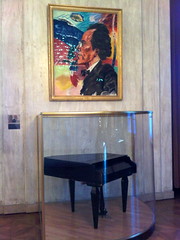Sir Georg Solti: Mahler Symphony No. 1
Chicago Symphony
| Mahler's Piano (Photo credit: Ethan Prater) |
I. Langsam. Schleppend
II. Kräftig bewegt, doch nicht zu Schnell (15:48)
III. Feierlich und gemessen, ohne zu schleppen (23:38)
IV. Stürmisch bewegt (35:17)
The Symphony No. 1 in D major was mainly composed between late 1887 and March 1888, though it incorporates music Mahler had composed for previous works. It was composed while Mahler was second conductor at the Leipzig Opera, Germany. Although in his letters Mahler almost always referred to the work as a symphony, the first two performances described it as a symphonic poem or tone poem. The work was premièred at the Vigadó Concert Hall, Budapest in 1889, but was not well received. Mahler made some major revisions for the second performance, given at Hamburg in October 1893; further alterations were made in the years prior to the first publication, in late 1898. Some modern performances and recordings give the work the title Titan, despite the fact that Mahler only used this label for two early performances, and never after the work had reached its definitive four-movement form in 1896.
The work includes two themes from Mahler's song cycle Lieder eines fahrenden Gesellen (1883--1885), and the available evidence also seems to indicate that Mahler recycled music from his abandoned opera project Rübezahl.
The opening of the third movement features a double bass soloist performing a variation on the theme of "Frère Jacques", distinguishing it as one of the few symphonic pieces to use the instrument in such a manner. Mahler uses the song, which he cites as "Bruder Martin", changed from major to minor, thus giving the piece the character of a funeral march. The mode change to minor is not an invention by Mahler, as is often believed, but rather the way this round was sung in the 19th and early 20th century in Austria
Valery Gergiev: Mahler Symphony No. 2
London Symphony Orchestra
| English: Mahler's Komponierhäuschen (composition hut) at Maiernigg (near Klagenfurt) on the shores of the Wörthersee in Carinthia. (Photo credit: Wikipedia) |
1. Allegro maestoso (Totenfeier)
2. Andante moderato
3.(Scherzo) In ruhig fliessender Bewegung
4. "Ulricht". Sehr feierlich, aber schlicht
5. Im tempo des Scherzos
Elena Mosuc, soprano
Zlata Bulychea, contralto
Daniele Gatti: Mahler Symphony No. 9
Wiener Philharmoniker
Concert of Concert of 2011 International Mahler Festival in Leipzig at Gewandhaus Leipzig on 28th May 2011.
Previously on Mahler Symphonies Best Performances:
Mahler Symphony No.1 Titan:
Claudio Abbado, Lucerne Festival Orchestra
Daniele Gatti, Wiener Philharmoniker
Franz Welser-Möst, Wiener Philharmoniker
Georges Prêtre, Wiener Philharmoniker
Gustavo Dudamel, Los Angles Philharmonic
Klaus Tennstedt, London Philarmonic
Leonard Bernstein
Lorin Maazel, New York Philharmonic
Mariss Jansons, Royal Concertgebouw Orchestra
Pietari Inkinen, Orchestra Sinfonica Nazionale della RAI (RAI National Symphony Orchestra)
Rafael Kubelik
Mahler Symphony No.2 in C minor "Resurrection":
Bernard Haitink, Royal Concertgebouw Orchestra
Claudio Abbado, Vienna Philharmonic Orchestra
Giuseppe Sinopoli, RAI Turin Symphony Orchestra (Orchestra Sinfonica di Torino della RAI)
Gustavo Dudamel, Simon Bolivar Symphony Orchestra, BBC Proms
John Barbirolli, Stuttgart Radio Symphony
Leonard Bernstein
Mariss Jansons, Royal Concertgebouw Orchestra
Simon Rattle, BBC Proms
Zubin Mehta, Wiener Philharmoniker
Mahler Symphony No.3 in D minor:
Bernard Haitink, Wiener Philharmoniker
John Barbirolli, Berlin Philharmonic
Leonard Bernstein
Mariss Jansons, Symphonieorchester des Bayerischen Rundfunks
Paavo Järvi, HR Sinfonieorchester Frankfurt
Semyon Bychkov, WDR Sinfonieorchester Köln
Mahler Symphony No.4 in G major:
Bernard Haitink, Royal Concertgebouw Orchestra
George Szell, Cleveland Orchestra
John Barbirolli
Kurt Sanderling
Leonard Bernstein
Mariss Jansons, Symphonieorchester des Bayerischen Rundfunks
Paul Kletzki
Simon Rattle, Wiener Philharmoniker
Valery Gergiev, World Orchestra for Peace, BBC Proms
Willem Mengelberg, Royal Concertgebouw Orchestra
Mahler Symphony No 5:
Bernard Haitink, Royal Concertgebouw Orchestra
Bruno Walter, 1947
Claudio Abbado, Wiener Philharmoniker
Daniele Gatti, Wiener Philharmoniker
Daniele Gatti, Royal Concertgebouw Orchestra
Daniele Gatti, Symphonieorchester des Bayerischen Rundfunks
Leonard Bernstein
Václav Neumann, Gewandhausorchester Leipzig
Valery Gergiev, World Orchestra for Peace, BBC Proms
Mahler Symphony No. 6 'Tragic':
Bernard Haitink, Chicago Symphony Orchestra
Leonard Bernstein
Mariss Jansons, Symphonieorchester des Bayerischen Rundfunks
Mariss Jansons, Royal Concertgebouw Orchestra
Mahler Symphony No.7 in E minor "Lied der Nacht":
Bernard Haitink, Symphonieorchester des Bayerischen Rundfunks
Daniel Barenboim, Staatskapelle Berlin
Eliahu Inbal, Frankfurt Radio Symphony Orchestra
Leonard Bernstein
Paavo Järvi, Frankfurt Radio Symphony, Rheingau Musik Festival
Mahler Symphony No.8 in E flat major "Symphony of a Thousand":
Christian Thielemann, Münchener Philharmoniker
Christoph Eschenbach, Orchestre de Paris
Edo de Waart, Netherlands Radio Philharmonic
Leonard Bernstein
Simon Rattle, BBC Proms
Wyn Morris, Israel Philharmonic
Mahler Symphony No.9 in D major:
Bernard Haitink, Wiener Philharmoniker
Bernard Haitink, Royal Concertgebouw Orchestra
Carlo Maria Giulini, Chicago Symphony Orchestra
Carlo Maria Giulini, Philadelphia Orchestra
Christoph Eschenbach, Orchestre de Paris
Jascha Horenstein
Kirill Kondrashin
Leonard Bernstein
Rafael Kubelik
Roger Norrington, Stuttgart Radio Symphony
Václav Neumann, Gewandhausorchester Leipzig
Mahler Symphony No.10 in F sharp major:
Carlo Maria Giulini, Los Angeles Philharmonic Orchestra
Claudio Abbado, Vienna Philharmonic Orchestra
Eliahu Inbal, Royal Concertgebouw Orchestra
Jun Märkl, MDR Sinfonieorchester
Leonard Bernstein
Pierre Boulez, Wiener Philharmoniker












